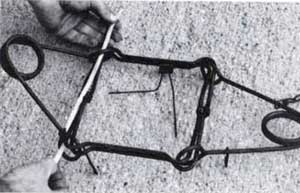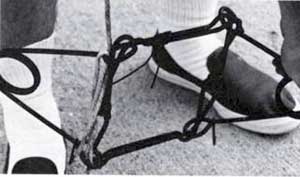Gun Dogs and Land Trapping
|
 A conibear trap with over 8 inches of jaw spread is prohibited for land trapping and is used in water sets only. |
There are two other forms of traps, the snare and the body-gripping trap, which is commonly called the conibear. The snare completely encircles the neck or limb of a target animal. The conibear, as illustrated, has one or two springs that close by the tripping of a trigger as the animal passes through the center of the trap. The conibear is used for some species in water trapping. Most predators are too shy and avoid the trap design. The use of snares and conibears are subject to separate specific regulations in each state’s small game trapping laws. Most states allow the use of snares or conibears on farmland and in urban areas only as a water set. A water set is usually described as any body-gripping trap or snare set so that the trap jaws or snare loop are at least half-submerged in water. Further restrictions on the snare include the diameter of the snare loop not exceeding 10 to 12 inches or being set more than 12 to 16 inches above the ground.
When hunting in the upper Midwest, you have the greatest chance of running into a trapper’s set during mid-October to mid-December, when pelts are at their prime. The season can be longer or shorter. An early heavy snowstorm will shut down most trappers because the leghold trap does not function well under adverse field conditions.
Most furbearers in the field are caught in leghold traps by using what is commonly described as a dirt-hole set. The trapper will usually use a No. 1-1/2 or No. 2 coil spring. Attached to the trap will be a metal tag that includes the name and address of the trapper. In addition, an eighteen- to twenty-four-inch metal stake secures the trap. Special components to the set include a trap cover, feather attractors, lure, and bait. The set is designed to simulate a location where a furbearer has buried a food-catch for later eating. As a hunter in the field, you will not see the dirt-hole set unless you are an experienced trapper, but your gun dog will pick up the scent.
If your gun dog has been caught, what do you do? Your dog can be easily released from the leghold trap without harm by simply compressing the trap spring levers on each side of the closed jaws. Your first objective should be to calm the dog. If the dog is overreacting, remove your hunting jacket and place it over the dog. This should allow you to calm the dog down so you can remove the trap. The leghold trap should not cause any permanent injuries. In fact, studies have shown that foot damage to fragile-boned red and gray foxes is less than one percent after the animal has been held during legal trapping hours.
To remove a gun dog from a snare is as simple as the removal from a leghold trap. Again, if the dog is fighting the set, be sure to calm him first. As the photo illustrates, to remove the snare just pinch the clasp that closes it. This will allow you to slide the snare open. It’s that simple.
The chances of your gun dog running into a conibear are slim due to the fact that the trap is usually retricted to a water set. With a small piece of rope or your dog’s lead, you can release a dog quickly from a conibear (see photos).
Trappers have not been working the fields like they did in the Seventies and early Eighties. However, trappers continue to play a vital role in the furbearer harvest. Wildlife experts agree that leghold traps are an essential tool in the proper management of furbearers. With the high reproduction rates of furbearers, the need for a controlled harvest will continue and the leghold trap will remain an important trapping tool.
You can avoid having your gun dog trapped by simply asking the landowner if a trapper is working the fields you are going to hunt. If you are approaching a trapped furbearer, avoid disturbing the set. And remember that gun dogs can be released easily from a trap.

Releasing a dog from a conibear trap is a bit more complicated than
opening a simple foot-hold trap or snare, but it is not difficult.
Most people have strength enough to simply squeeze the spring
(first the left, then the right) arms togheter and place each
setting hook into the lock position. If strength is not enough,
a four-foot piece of rope works.

After the dog is quieted, the rope is woven through the loops at
the ends of each spring arm.

The setting hook is then placed into
the lock position, and one side of the trap is loose. By repeating
these actions on the opposite
spring, the dog is free. With a clip tied on one end, the rope
doubles as a lead.

By standing on one end of the rope and pulling on the other, the
arms easily come together.

A cross section of a dirt hole set commonly used by trappers. |


A land trapper will use a No. 1-1/2 or No. 2 coil spring placed
in front of a small two-inch wide by 12 inch deep hole.
You will not be able to see the dirt-hole set, but your gun dog will smell the trap location and develop an interest in it.

The cable snare is restricted to water sets and non-farm areas in most states.
The chances of your gun dog running into one are slim. To remove the snare,
just pinch the clasp to draw slack on the cable, which allows the snare to
slide open.
TIPS
Videos and Articles on Kennel Design and Dog Training.
INSTALL
Pet Door Installation Instructions
with Training Tips.
BLOG
News, Features and More! Come Visit.
Thank You, Lance & Marcie
|
|
1-800-789-0203 • 701-354-7700 • Fax
701-354-0117
13835 34th St NW • Bismarck, ND 58503 International 701-354-7700 Copyright © 1992-2025 Gun Dog House Door® Inc. |



